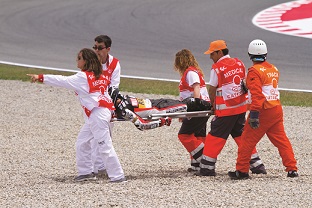

In the next few pages, we’ll have a look at the types of problems that can arise, with tips for dealing with them. Planning and implementing a solidly structured medical support scheme for sports events is as important. (For example, in the case of an obstacle race, it is important to make sure the obstacles and targets are secure and perform as designed, and that there are plans in place in case of injuries.)
Combined, a good event and adequate precautions will produce an event as fun to be in as to watch and one that goes on to engage new crowds into the future.
Matters of the Skin and Soft Tissues
Skin is more than a covering that keeps your organs in, it is a living, breathing part organ, the largest organ in your body it. When abraded, cut, punctured, burned or blistered, urgent attention is often needed.
A light abrasion to the skin can be treated by just cleaning it with mild soap and water and covering with an appropriate dressing. While small cuts, with minimal bleeding and no deformity, may respond to cleaning, pressure and a dressing, more substantial insults to skin integrity may require more aggressive forms of closure. If appropriate equipment and personnel for suturing is not available, transport to a medical facility is needed. With punctures, along with assessing the depth and potential injury caused by the trauma, the need for tetanus prophylaxis must be included as well.
Burns, such as sunburn, are common. Reddening of the skin and pain over the affected area are characteristic of a first degree burn. A light scald, such as from a hot beverage, may cause a similar burn. Those can usually be treated with cool water and a loose dressing. Once there is blistering of the skin, the injury has progressed to a second degree burn, which requires more careful attention; third degree burns, with blackened skin and loss of skin sensation and integrity, is an emergent situation which requires tertiary care.
Blisters, which often occur on the hands and feet, should be kept clean and the pressure point relieved or remedied. Blisters should not be broken; in fact, further trauma to the area involved should be avoided, so as not to worsen the injury.
Matters of Bones, Muscles and Tendons
Strains and sprains are likely consequences of extreme (or even not so extreme) sports. Competent individuals, whether athletic trainers, paramedical or medical personnel, should be on hand to assess any such injuries and provide appropriate treatment. Depending on the severity of injury, old-fashioned RICE therapy (Rest, Ice, Compression and Elevation) may be all that is needed or there may be a need for more structured local treatment or referral for full evaluation. While most such injuries are likely to be minor, the real possibility of a major muscle tear or tendon rupture lurks in the wings and must be considered.
While the prospect of a broken bone might sound like an obvious condition, there are bone injuries which are sometimes missed; these include stress fractures of the feet, compression fractures of the spine or others. A fall could break a hip but it can also cause a closed fracture of the pelvis, which the athlete may try to ignore. A trip and a bloody nose could also mean a broken nose.
Make sure those afflicted are evaluated carefully by skilled individuals, allowed a place to rest and to be treated if indicated or transported for further care if needed. Suitable facilities and methods for transportation need to be planned into the system and implemented as needed.
Matters of the Eyes and Ears
A wide variety of incidents can impact vision and hearing. Tools and personnel and plans must be available for possible issues.
Eye injuries can range from impact to the globe, itself, problems with spectacles or contact lenses, dust or particles in the eye or an abrasion to the cornea, among others. Clear protocols for evaluating eye injuries, including assessment of vision, ability to move the eye, eye pain and redness, deformity, bruising and associated trauma, among others, should be formalized into an algorithm that can be followed by first responders at the event. Eye wash materials may be needed in the case of foreign material in the eye and a path for prompt ophthalmologic care established for any serious issues.
Ears can be impacted by loud noises, such as guns, air horns or motors, with temporary or more permanent loss of hearing. Foreign objects in the ear, including ear plugs or ear buds worn for music, can become impacted in the ear with a fall and can damage the eardrum. Water sports can leave residual fluid in the ear, a problem for those prone to ear infections.
Matters of the Heart and Lungs
One would think that people engaging in sports would be in the best cardiovascular condition. Unfortunately, this is not always the case and the probability of a heart or lung problem remains quite real. As with other areas, suitable plans for evaluation, management at the scene and triage to higher levels of care if needed, must be established.
Chest pain, shortness of breath, profuse sweating, nausea with any of those symptoms and even shoulder and jaw pain must be remembered as hallmark signs of heart disease. While athletes may deny any such problems, they must still be considered as having possible cardiac problems. Runners ostensibly in good health have been known to suffer heart attacks. If a participant is showing signs suggestive of heart problems, that person be fully evaluated for what may be undiagnosed heart disease.
All participants should have information on their own medical history, with names of medications taken, allergies and physicians’ names and telephone numbers.
Shortness of breath can also be related to asthma and chronic lung disease and this also requires prompt intervention. Use of personal medications, such as metered dose inhalers, may be appropriate, along with evaluation of pulse oximetry and level of distress. Under all but the most minor of such issues, the person may need a more comprehensive level of care than could be provided at a sports venue.
For these, which may be among the more serious, injuries and condition, clear guidelines, protocols and avenues of triage are of utmost importance. Written guidelines, open channels of communication and available assistance should be part of the system in place.
Matters of the Brain
A head injury from a fall, an impact with another contestant or with an object, raises the issue of concussion. Often shrugged off in times gone past, the injury to the brain produced by a concussion is now a real and recognized habit of many forms of sport. Anyone suffering a head injury should be evaluated for possible concussion, with appropriate steps taken based on that evaluation.
Clearly, if an individual is “knocked out,” loses consciousness or is acting abnormally after an injury with abnormal speech, gait, mentation or with vomiting, immediate transportation to a suitable facility is needed. For those head injuries where it is not quite so clear, there are a variety of screening tools currently in use which can assist in the evaluation. The SCAT-3 test is one such tool and there are others available from the CDC and in use by various organizations. The key point is to become familiar with a valid assessment tool and use it whenever appropriate.
Matters of Health
It sounds as though the medical planning for an event can overshadow the planning for event itself and threaten to dampen the enjoyment and excitement of extreme sports. The truth is that such planning is needed to help the athletes perform at their best and compete again in the future.

